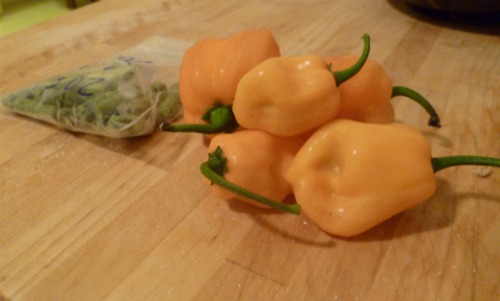Food Studies features the voices of 11 volunteer student bloggers from a variety of different food- and agriculture-related programs at universities around the world. You can explore the full series here.
 Hops and habaneros.Photo: Erin RossI feel like I’ve always known that the nose plays an important part in the way that we taste. I have a childhood memory of my mom asking my sister and I to do an experiment where we pinched our noses and, with our eyes closed, ate something (a raspberry, I think) and had to guess what it was. I still remember that it was curiously hard to discern what I tasted, although back then I didn’t understand why.
Hops and habaneros.Photo: Erin RossI feel like I’ve always known that the nose plays an important part in the way that we taste. I have a childhood memory of my mom asking my sister and I to do an experiment where we pinched our noses and, with our eyes closed, ate something (a raspberry, I think) and had to guess what it was. I still remember that it was curiously hard to discern what I tasted, although back then I didn’t understand why.
That ignorance continued through subsequent bad allergy attacks or head colds, which also seemed to deaden my taste buds — and take my appetite away with them. Now, after the first two weeks of my “Food and the Senses” course (a core class for all Boston University gastronomy majors), I’m finally beginning to understand the importance of smell in creating the nuances that make eating such a delightful and complex experience.
The first week of readings for the class ranged from excerpts of scientific journals to a story from the New Yorker magazine. Two of the scientific articles (one by David V. Smith and Robert F. Margolskee [PDF], the other by Cathy Pelletier), drove home the fact that what we think of as taste is actually a neural interaction between what we experience with our taste buds and smell receptors, and the tactile sensations created as food is being munched, (technically known as “mouthfeel”). In fact, the majority of the little bumps on our tongues are involved in tactile sensation rather than taste — they are what enables us to experience the burn of chili peppers for example.
Most people have heard that there are only four or five basic tastes — sweet, sour, salty, bitter, and perhaps umami — but I was also fascinated to learn that taste works like vision, in which the brain discerns taste (or color) by comparing patterns of activity across a range of taste (or photo-) receptors, rather than by relying on a dedicated receptor to detect sour, or yellow. Learning this affirmed that what we experience as taste is actually a spectrum of flavors blending together.
The importance of the complex interaction between smell, taste, and mouthfeel was brought to life in an incredible article from the New Yorker, which described the experience of Grant Achatz, the famous chef from Alinea, who lost his sense of smell and taste to cancer, but kept cooking, and eventually regained his senses. He described the experience of drinking a vanilla milkshake after he recovered his sense of smell, but before he had regained his sense of taste:
You make yourself a vanilla milkshake. Grab some Häagen-Dazs vanilla, add whole milk. You think you know what it’s going to taste like, and it tastes like nothing. All you get is thick texture. You get vanilla because you can smell it, but there’s no sweetness. It’s bizarre.
I’ve been lucky that while reading these articles I’ve had the opportunity to try some interesting wines paired with some delicious food. I’ve been surprised by an un-oxidized sherry that smelled grapey and cloying, but tasted more like green apples, and paired great with savory potato chips. A few nights later, I had the same sherry but this time paired with seaweed pasta dotted with fried anchovies. Though I was fascinated by the interplay of the different flavors, I found myself acutely aware of how my sense of smell influenced the pairings.
I realized how much more I was paying attention to my sense of smell last weekend, when my boyfriend and I began a batch of habanero beer we’ve been talking about brewing for months now. We started with a basic recipe that he had made before, but had to substitute a variety of hops called saaz for ones he had used previously, but that the brewing supply store no longer had in stock.
Immediately, I noticed that in addition to their floral, hoppy smell, they also had notes of spiciness, and were intensely savory, almost like cheese. I wanted to see whether that smell translated into an umami taste sensation, too, so we crushed some of the green pellets on the counter and ate them. I expected the raw hops to taste blindingly bitter, but in fact their taste reminded me of their smell, with the bitterness on the finish, and floral notes on the start. The complex savory and spicy notes rested somewhere in the middle. When we threw the hops in the pot with the rest of the ingredients their savory smell wafted through the rest of the kitchen.
After the beer finished cooling in its pot for an hour or so, we transferred it to a bucket, and tasted it. At this early stage, it was overly sweet and not as complex as the raw hops were. We added in the yeast, and crossed our fingers that as the yeast eats off the sugars the beer will begin to taste reminiscent of how it had smelled. If we’re lucky, when we transfer the beer to a secondary container and add the habaneros in a weeks time, we’ll not only get the heat level right, but their intense flavor will compliment the flavor of the hops. Hopefully we’ll have made a beer that is simultaneously savory, sweet, spicy, and cold. I’ll keep you posted!



